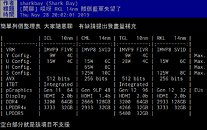- Joined
- Oct 9, 2007
- Messages
- 47,670 (7.43/day)
- Location
- Dublin, Ireland
| System Name | RBMK-1000 |
|---|---|
| Processor | AMD Ryzen 7 5700G |
| Motherboard | Gigabyte B550 AORUS Elite V2 |
| Cooling | DeepCool Gammax L240 V2 |
| Memory | 2x 16GB DDR4-3200 |
| Video Card(s) | Galax RTX 4070 Ti EX |
| Storage | Samsung 990 1TB |
| Display(s) | BenQ 1440p 60 Hz 27-inch |
| Case | Corsair Carbide 100R |
| Audio Device(s) | ASUS SupremeFX S1220A |
| Power Supply | Cooler Master MWE Gold 650W |
| Mouse | ASUS ROG Strix Impact |
| Keyboard | Gamdias Hermes E2 |
| Software | Windows 11 Pro |
Intel's 11th generation Core "Rocket Lake-S" desktop processor will come in core-counts only up to 8, even as its predecessor, "Comet Lake-S," goes up to 10. Platform descriptors for Intel's next four microarchitectures surfaced on the web, detailing maximum values of their "S" (mainsteam desktop), "H" (mainstream notebook), "U" (ultrabook), and "Y" (low power portable) flavors. Both "Comet Lake-S" and "Rocket Lake-S" are 14 nm chips. "Comet Lake-S" comes with core counts of up to 10, a TDP of up to 125 Watts, Gen 9LP iGPU with 48 execution units, and native support for up to 128 GB of DDR4-2667.
The "Rocket Lake-S" silicon is interesting. Rumored to be yet another derivative of "Skylake," it features up to 8 CPU cores, the same 125 W maximum TDP, but swanky Gen12 iGPU with 32 execution units. The memory controller is also upgraded, which supports DDR4-2933 natively. There is no "Ice Lake-H" or "Ice Lake-S" in sight (no mainstream notebook or mainstream desktop implementations), ditto "Tiger Lake." For the foreseeable future, Intel will only make quad-core designs of the two 10 nm microarchitectures. "Rocket Lake-S" is slated for 2021 when, hopefully, we'll see Intel escape the 14 nm black hole.

View at TechPowerUp Main Site
The "Rocket Lake-S" silicon is interesting. Rumored to be yet another derivative of "Skylake," it features up to 8 CPU cores, the same 125 W maximum TDP, but swanky Gen12 iGPU with 32 execution units. The memory controller is also upgraded, which supports DDR4-2933 natively. There is no "Ice Lake-H" or "Ice Lake-S" in sight (no mainstream notebook or mainstream desktop implementations), ditto "Tiger Lake." For the foreseeable future, Intel will only make quad-core designs of the two 10 nm microarchitectures. "Rocket Lake-S" is slated for 2021 when, hopefully, we'll see Intel escape the 14 nm black hole.

View at TechPowerUp Main Site










